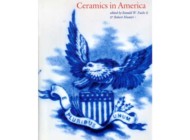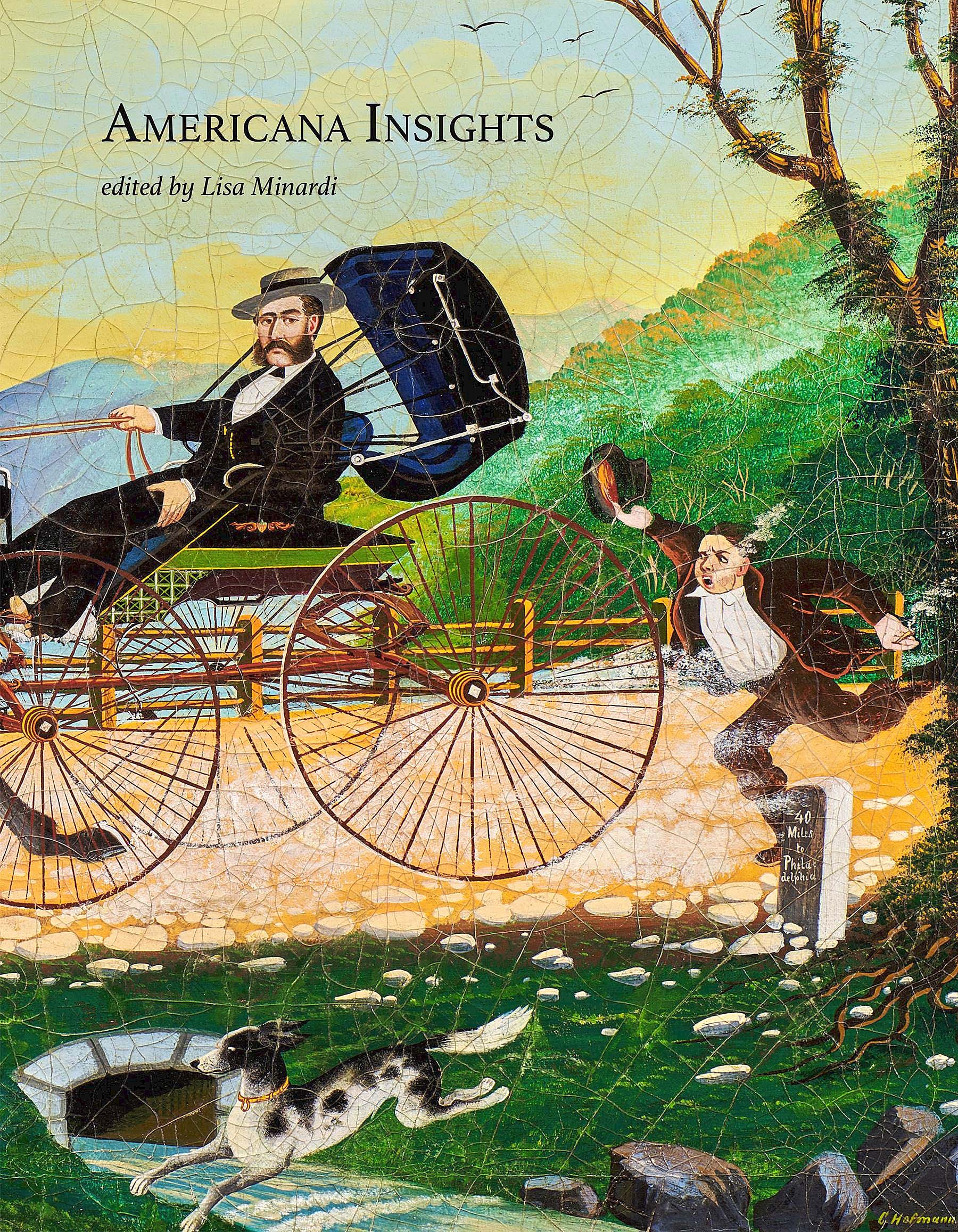
Americana Insights. Edited by Lisa Minardi and Trevor Brandt, with contributions by Matthew E. Monk, Trevor Brandt, Amelia Peck and Cynthia V.A. Schaffner, Paul S. D’Ambrosio, Jennifer M. Swope, Christopher Malone, Tobin Fraley, Christian Roden, Richard Miller, Eileen M. Smiles and Emelie Gevalt. Published by Americana Insights and distributed by the University of Pennsylvania Press, Philadelphia, 2024, pp. 274, $65, hardcover.
In the fall of 2023, the first volume of Americana Insights was published and reviewed in this publication. It was one of the last projects finished by the book’s founding editor Robert E. Shaw, Jr, who passed away on October 16, as the inaugural issue was being released. Under the auspices of founders Jane Katcher and David A. Schorsch, editor Lisa Minardi continues to pilot the publication, now assisted by managing editor Trevor Brandt. Where the first volume had 10 essays and two briefs, the second issue presents eight essays and four briefs; constants between both are its high standards for rigorous scholarship and visual aesthetics.
An essay on the history of Cherokee rivercane basket collecting kicks off the periodical. It was written by weaver, knitter and quilter Matthew E. Monk, who is also a PhD candidate at the University of Delaware studying Appalachian crafts, traditions and revivals. In “Double Woven: A History of Cherokee Rivercane Basket Collecting, 1690-1947,” Monk highlights the secret of basketweaving unlocked in 1940 by Lottie Stamper (1906-1987), a member of the Eastern Band of Cherokee and a basket-making instructor at the Cherokee School in Cherokee, N.C. Once she’d learned how earlier tribes made the baskets, Stamper developed a method of teaching those traditional techniques to classes of Cherokee students. This, combined with a booming postwar craft-tourism economy, led to a resurgence of double-weave basket making. Monk’s essay thoughtfully explores the historical relationship of the double woven rivercane baskets, Cherokee identity and economy and Euro-American collecting through an examination of the economic and material history of the trade.
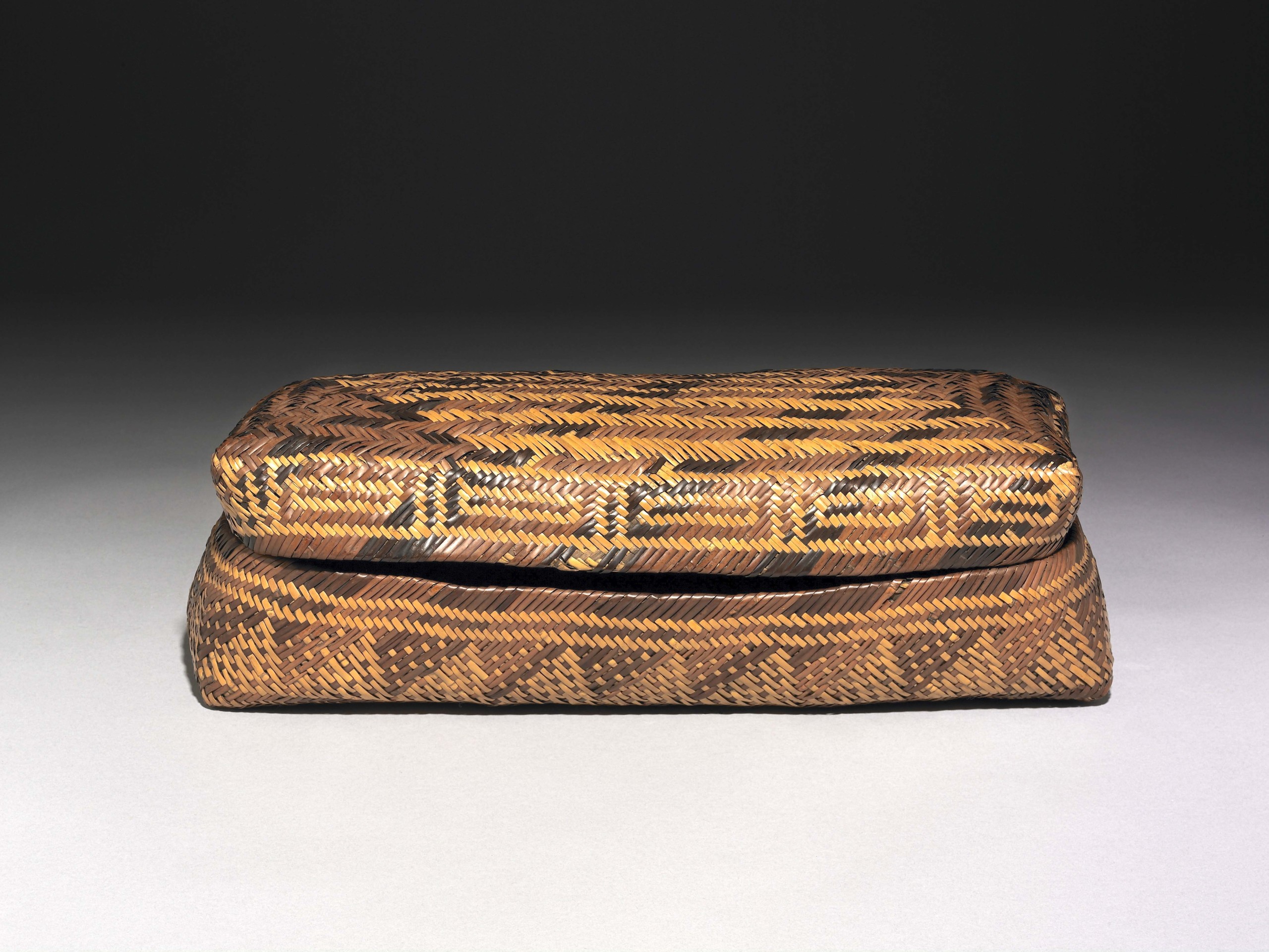
Basket, once-known maker, South Carolina, circa 1720s, rivercane and pigments, 7½ by 40 by 16 inches. British Museum, London. Am, SLMisc.1218.a-b. Photo ©The Trustees of the British Museum.
Trevor Brandt’s exploration of materials — brocade paper, pigments and metallic foils — used from the mid Eighteenth to the mid Nineteenth Century to make German-language fraktur follows. In “Fancy Fraktur: Brocade Paper in Pennsylvania German Folk Art,” Brandt breaks new ground in the scholarship, arguing that the decoupage-like layering of materials transforms each certificate into a sculptural three-dimensional object previously considered quaint, naïve or primitive.
The focus moves from paper to fabric in “The Global Roots of an American Family Record Sampler,” which was co-authored by Amelia Peck (author and curator at the Metropolitan Museum of Art) and Cynthia V.A. Schaffner (decorative arts historian, author and researcher at the Metropolitan Museum of Art). At the heart of Peck and Schaffner’s research is the Poyen family record sampler, which was acquired by the Metropolitan Museum of Art in 2020. Made circa 1819, the sampler’s provenance is unfolded to reveal a story of French Canadian immigration and the family’s assimilation in Massachusetts.
Sturtevant J. Hamblin (1816-1884) is no stranger to folk art collectors and is best known for itinerant portraits he painted alongside those of his older brother-in-law, William Matthew Prior (1806-1873), which are collectively recognized by the market as “Prior Hamblin School.” Previous scholarship has focused on Prior, so Paul S. D’Ambrosio’s research gives him his due. D’Ambrosio, president and CEO of the Fenimore Art Museum in Cooperstown, N.Y., expands on the scant existing scholarship and fleshes out an extensive profile of an artist who has, for too long, gone unrecognized.
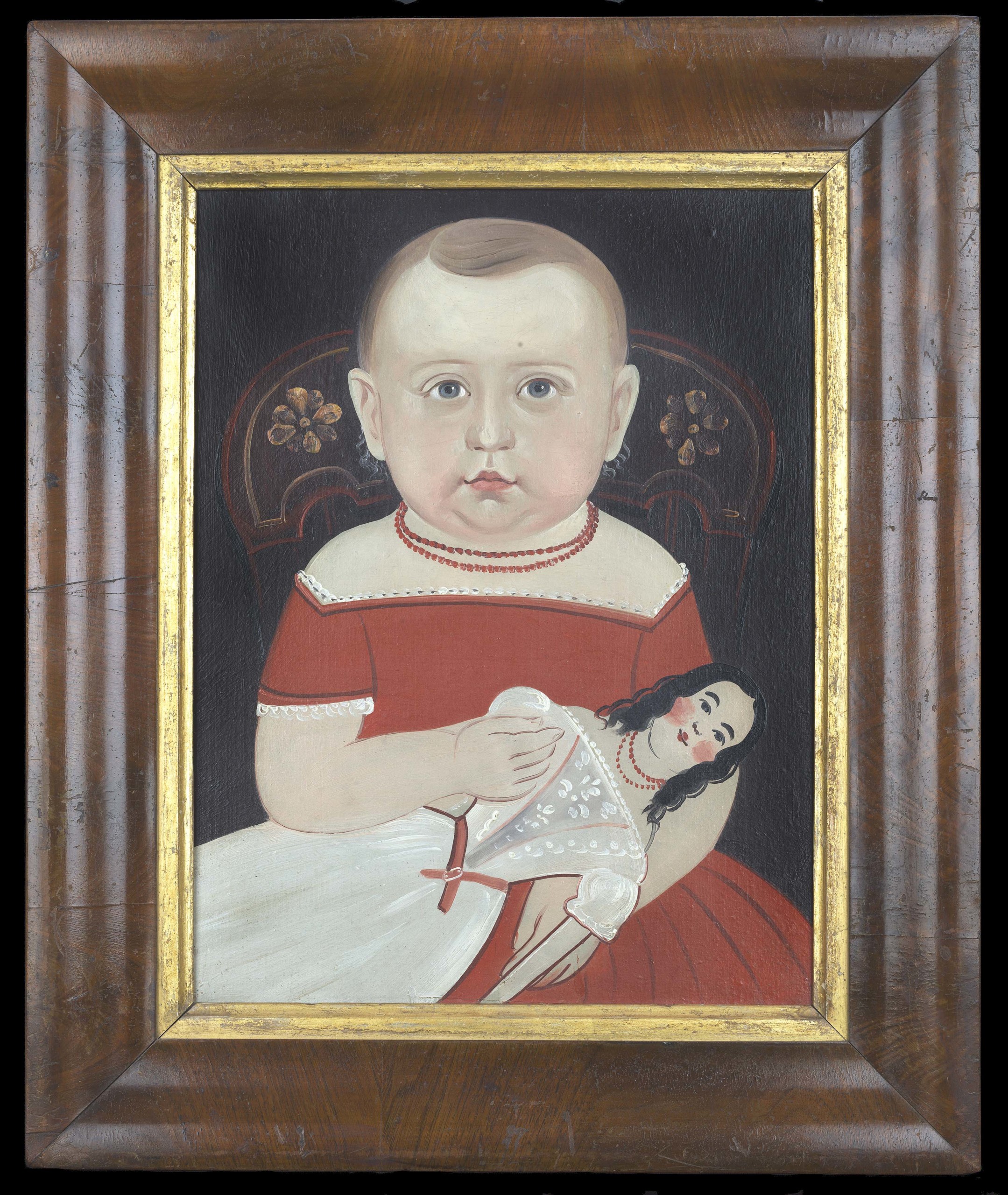
“Baby with Doll” attributed to Sturtevant J. Hamblin, probably Boston or East Boston, Mass., circa 1845, oil on academy board, 15¾ by 12¼ inches. Abby Aldrich Rockefeller Folk Art Museum, 54.100.1.
An exhibition on American bedcovers (“Fabric of a Nation: American Quilt Stories”) at the Museum of Fine Arts, Boston, from 2021 to 2022, was curated by Jenniver M. Swope, the MFA’s David and Roberta Logie curator of textiles. A catalog for the exhibition — which, following Boston, was at the Skirball Cultural Center in Los Angeles and, until recently, at the Summer Museum of Art and Gardens in Jacksonville, Ga. — was published and Swope’s article of the same name treats readers to highlights from the show and some insights revealed in launching it.
Charles C. Hoffman’s (1821-1882) landscapes of life along the Schuylkill River have been sought-after by folk art collectors or institutional collections for decades, but little was known about the itinerant artist who died penniless and destitute in the Berks County Almshouse. Christopher Malone, a scholar of Pennsylvania German material culture who recently became curator at Historic Trappe, explores Hoffman’s life in “Charles C. Hofmann’s Paintings Along the Schuylkill River: Landscapes of Peace, Prosperity and Despair.” Along with assembling a list of 36 known works by Hoffman, Malone’s article also provides readers with a better understanding of the almshouses that were a presence in the life of many Nineteenth Century citizens.
Carousel historian and author Tobin Fraley penned his recent scholarship in “Daniel Carl Müller: The Artist as Carousel Carver.” He addresses the problem of classifying carousel figures within the terms of “folk art,” “craftsmanship,” “commercial art” and “fine art.” He discusses the history of the American carousel and its evolution from a European antecedent, the artistry of Müller as craftsman, the end of the Golden Age of the wooden carousel and the revival of interest in carousel history in the 1970s and 80s.
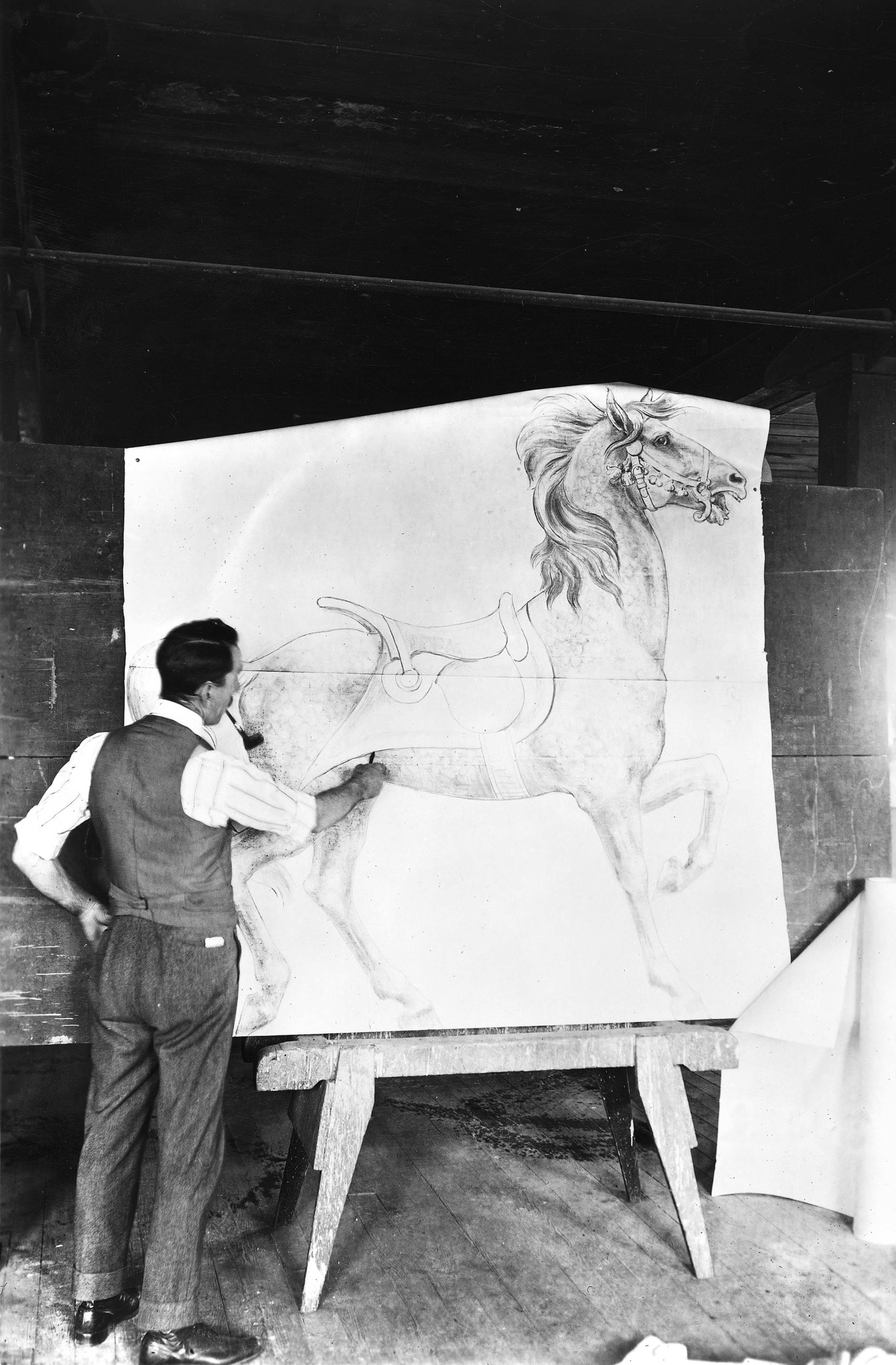
Daniel Carl Müller sketching a standing horse, Germantown, Penn., 1921. Courtesy of the Tobin Fraley Archive. Photo: Underwood & Underwood.
The last essay in Americana Insights focuses on the collections of Eighteenth and Nineteenth Century Americana housed onboard two ocean liners launched in 1951 as part of the American Export Lines fleet, SS Independence and SS Constitution. The ultramodern machinery and interior fixtures of these two vessels was in direct contrast with their collections, a strategic and concerted ploy by industrial designer, Henry Dreyfuss (1904-1972). He selected objects that were not only representatives of an “American style,” but which also favored pieces made by anonymous craftspersons, merchants and laborers, in which tradition was celebrated alongside technology. Vintage interior photos are shown alongside object photos in “Americana on the Atlantic: Creating National Identity on the Mid-Century Ocean Liner” by Christian Roden, independent historian of maritime history, art and design.
Johannes Bard (1797-1861) was originally thought to have just painted fraktur, but new avenues of research into the artist’s oeuvre came to light with the discovery of a group of nearly 50 ink and watercolor drawings that had remained in his family for more than 170 years. Richard Miller, a consulting researcher at the Chipstone Foundation and formerly a curator of sculpture and decorative arts at the Abby Aldrich Rockefeller Folk Art Center at Colonial Williamsburg, explores these drawings in the first of four briefs.
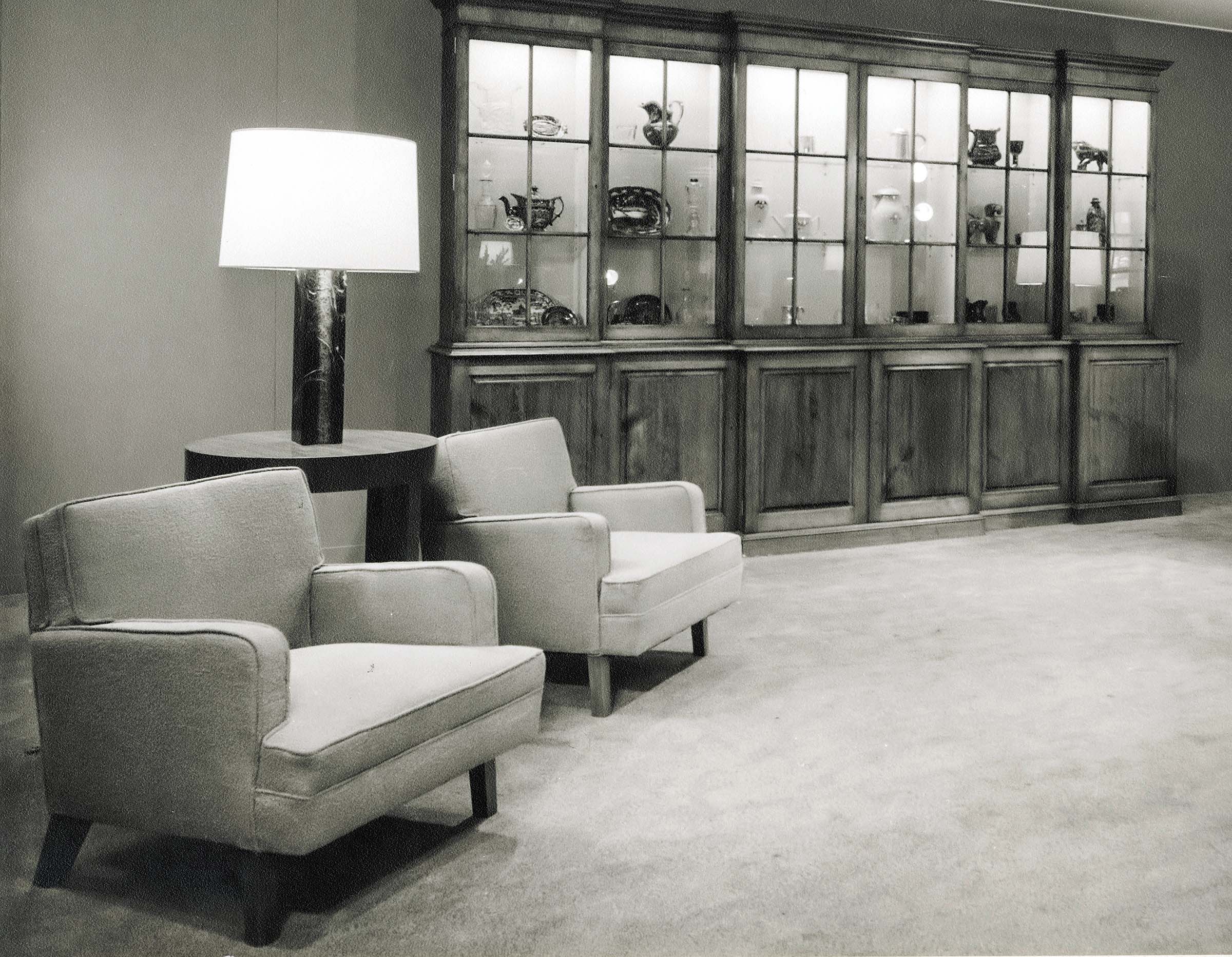
Interior view of the first-class lounge of the SS Independence, showing a breakfront containing objects loaned from the Metropolitan Museum of Art, 1951. Henry Dreyfuss Archive, Cooper Hewitt, Smithsonian Design Museum, 1972-88.149.20. Photo courtesy Office of Henry Dreyfuss.
Eileen M. Smiles, a dealer of American antiques and folk art, discusses in another brief the mid Nineteenth Century decorative sign and carriage painting businesses in Auburn, N.Y. Focusing first on that of John Clapp (1806-1882) and his brother, George Clapp (1808-1899), Smiles’ article expands on assistants and apprentices who branched out and further solidified Auburn as an important hub of ornamental painting.
The American Folk Art Museum’s (AFAM) current exhibition, “Playing with Design: Gameboards, Art and Culture” was inspired by the gift to the museum of about 100 Nineteenth and early Twentieth Century gameboards by Doranna and Bruce Wendel. Emelie Gevalt, AFAM’s curator of folk art and curatorial chair for collections, discusses the early scholarship of the genre and encapsulates some of the exhibition’s key points in her brief.
To close the issue, Paul S. D’Ambrosio makes an additional contribution in the form of a brief on William Matthew Prior, Sturtevant J. Hamblin’s brother-in-law. During research on Prior-Hamblin school photos in the archives of Fruitlands Museum, he stumbled upon a carte de visite of the artist, taken between 1860 and 1873, that had never been previously published or cited. D’Ambrosio pairs documentation that accompanied the photo with recollections of Prior by the artist’s son, Matthew Prior (1847-1942) and a summary of early Twentieth Century scholarship in a lively piece that breathes humanity into an artist whose works have long been the attention of scholars and collectors alike.
Americana Insights may be purchased at www.pennpress.org.










